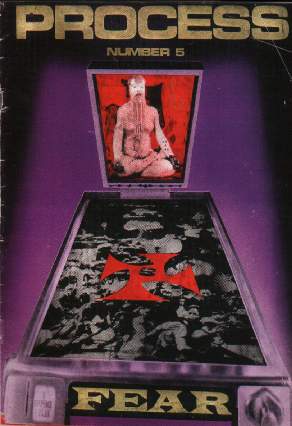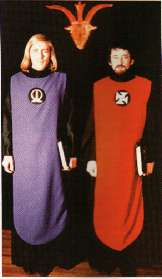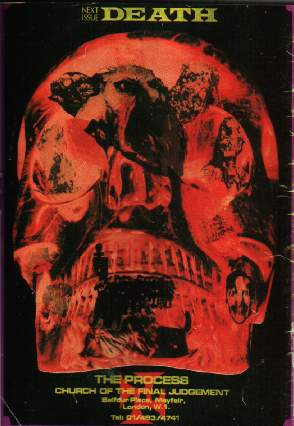
SYMPATHY FOR THE DEVIL
[originally from http://www.forteantimes.com/artic/134/process.html ]
"Death-worshipping church" or apocalyptic prophets? GARY LACHMAN investigates the Process Church of the Final Judgement, a Sixties movement with a far-reaching influence.
 Accused of being a "black-caped, black-garbed, death-worshipping church" with ranks of mindless "hooded snuffoids," they believed they were visionaries warning of the coming apocalypse. In the wake of the shootings at Columbine and with cult activity on the increase, this could have been ripped from the mainstream headlines throughout 1999. But at the end of the hippie dream, these were the charges levelled at one of the most controversial cults of the Sixties: the Process Church.
Accused of being a "black-caped, black-garbed, death-worshipping church" with ranks of mindless "hooded snuffoids," they believed they were visionaries warning of the coming apocalypse. In the wake of the shootings at Columbine and with cult activity on the increase, this could have been ripped from the mainstream headlines throughout 1999. But at the end of the hippie dream, these were the charges levelled at one of the most controversial cults of the Sixties: the Process Church.
In 1963, two people met at the L Ron Hubbard Institute of Scientology on Fitzroy Street, London. They were both studying to be ‘auditors’. Based on his earlier system of Dianetics, ‘auditing’ was Hubbard’s method of discovering and eliminating ‘engrams,’ the psychic residue from past traumas. The aim of auditing was to become ‘clear,’ to wipe the psychic slate clean and become, in effect, a kind of superman, no longer enthralled to neurotic fears and hang-ups.
Robert DeGrimston Moore (left) and Mary Ann McClean were both fascinated by auditing and soon grew proficient. Although they came from considerably different backgrounds, both were enthusiastic Scientologists. Born in Shanghai in 1935, Robert had served in the military as a cavalry officer, for awhile stationed in Malaya. He had a middle class upbringing, and had studied as an architect. He boasted an IQ of 163 and claimed to have been a member of MENSA. Tall, handsome, dreamy and charismatic, Robert was passive and emotionally dependent. A perfect match, it turned out, for Mary Ann.
Born in Glasgow in 1931, Mary Ann had a different sort of life. Her father left before she was born; not long after, her mother abandoned her. She was raised by relatives in an atmosphere of poverty and neglect. Attractive, driven and ambitious, by the early 1950s she had emigrated to the States; it’s a good chance she paid her way through prostitution. For a time she was married to the US boxing champ Sugar Ray Robinson. In the early 1960s, Mary Ann left Sugar Ray and moved to London. The split must have been profitable: she took a lease on an expensive flat and set up a high class call-girl service. She entertained some top flight customers, and had connections with the Profumo scandal. Manipulative, demanding and volatile, she knew how to exploit emotional needs and fostered dependence in those around her. She was attracted to Robert’s intelligence and charm. She knew she could use both, and she did.
 It was soon clear they were too intelligent and wilful to remain Hubbard’s followers. Robert (left) and Mary Ann had ideas of their own, and tested these successfully on some clients. Security on Fitzroy Street was high; when Mary Ann discovered her session rooms were bugged, she and Robert left. Mary Ann, who was sensitive to appearances, convinced Robert to drop Moore, which she thought sounded too common, and to adopt DeGrimston. They married soon after, and in 1964 they set up their own system.
It was soon clear they were too intelligent and wilful to remain Hubbard’s followers. Robert (left) and Mary Ann had ideas of their own, and tested these successfully on some clients. Security on Fitzroy Street was high; when Mary Ann discovered her session rooms were bugged, she and Robert left. Mary Ann, who was sensitive to appearances, convinced Robert to drop Moore, which she thought sounded too common, and to adopt DeGrimston. They married soon after, and in 1964 they set up their own system.
They were both interested in the work of Alfred Adler, a Freudian who had broken away to develop his own ideas. Adler, who developed the idea of the inferiority complex, believed that people were driven by what he called ‘secret goals,’ hidden agendas that gave rise to compulsions and neuroses. The idea was to discover these goals and make them conscious. Putting Adler and Hubbard together, Robert and Mary Ann created a new system – Compulsions Analysis.
When they tried the new therapy on some friends, the results were encouraging. The circle grew, with the initial people who had undergone ‘the process,’ as it began to be called, initiating others – all paying considerable fees to the DeGrimstons. Most of the early clients came from Robert’s set. Mary Ann’s friends tended to be from the shady side, but Robert moved among the bright lights of English youth. Young professionals – architects, artists, scientists, economists – formed the first core of the DeGrimstons’ following.
They took an office on Wigmore Street. Strange things began to happen. The group, which now numbered around 30, began to feel various ‘group mind’ effects. They also began to feel set apart from the rest of society. Like many ‘alternative’ groups in the Sixties, Compulsions Analysis moved from self-help to a kind of spiritual quest, as those that had gone through ‘the process’ began to regard the rest of society as a kind of bad dream. The DeGrimstons began to feel that what they had created was something more than a new therapy. They looked around for a new name, and decided on something that must have seemed obvious. In 1965, Compulsions Analysis, a derivative of Scientology, became the Process Church of the Final Judgement.
Mary Ann and Robert felt inspired. Divine powers were guiding them. When a member came into an inheritance, they convinced him to take out a lease on a mansion in Balfour Place in Mayfair and donate it to the Process. They also convinced him to decorate the place lavishly, even putting a brass plate on the door, featuring the new Process symbol Robert had designed. Four Ps joined in a kind of mandalic wheel, the symbol had an uncanny resemblance to the Nazi swastika .
But they were not long for Mayfair. The divine hand was pressing them on. Robert and Mary Ann began to yearn for some retreat from a world they increasingly regarded with disgust. In June, 1966, the DeGrimstons and a group of about 30 ‘Processeans’ – as they called themselves – left for Nassau. They were accompanied by the six Alsatian dogs the DeGrimstons had recently acquired – another suggestion from the divine powers. (Further suggestions included an $80,000 yacht and first class journeys to Turkey and Asia for the DeGrimstons.) Later, members emulating the leaders would acquire these dogs too.
After three months they left Nassau, still in search of their sanctuary. In Mexico City a group mind session suggested they hire a rickety bus and follow the Yucatan coast. Near Sisal they came upon a spot they had envisioned in their meditations. Xtul, a place of ruins, was near the beach, hugged by coconut palms; pronounced ‘Shtul’ the word meant ‘terminus’ or ‘end’ in Mayan. For the Process, however, it was only the beginning.
It was like paradise. Living on fruit and fish, swimming, making love, having group encounters – like many people in the Sixties, the Process had ‘gone back to nature’; they had escaped the rat race and were finding themselves. They wrote songs, chants, and poems about Xtul; everyone there would remember the time for the rest of their life, as if they had gone back to Eden. It had a profound effect on Robert, who began to identify with Jesus Christ.
But then disaster hit. A hurricane pummelled the group for three days. 200 mph (322 kph) winds in absolute darkness. Their shelters were flattened. It was as if demonic forces had been unleashed; yet miraculously the group survived. Local villages were devastated, but the Process emerged from the upheaval unharmed but not unchanged, Degrimston knew. It had been their rite of passage. The true nature of the universe had been revealed to him.
They had met the twin Gods of love and violence. At Xtul, he had begun to receive inspired teachings, what he called The Xtul Dialogues, communications from the god forces that ruled existence. He called them Jehovah, Satan and Lucifer. And now they had a mission: to return to London and preach the word of their imminent apocalyptic unification. For Christ and Satan, it was time to come together.
They returned to London filled with a sense of purpose. Their return, however, wasn’t a total triumph. While at Xtul, the parents of some underaged Processeans sent a solicitor to retrieve their children. In paradise, the solicitor encountered a bikini-clad Mary Ann DeGrimston, fawned on by ragged and underfed Processeans; he made a note of her long, silver-polished fingernails, and talked to the press. The Sunday Telegraph ran a negative story on the "Mind Benders of Mayfair." The ‘alternative’ press wasn’t too keen on them either; a highly critical article appeared in the counterculture gazette, Oz. But the DeGrimstons weren’t detered. Back at Balfour Place they opened a 24-hour coffee bar called Satan’s Cave.

The group had made a sudden shift. They began to wear black capes and black turtle necks, and to sport shiny silver crosses. They also wore badges featuring the sinister Goat of Mendes, the devil headed demon of the witches’ sabbath. The Process symbol too was prominent. Divine intervention continued. They set up a lecture hall and bookshop, and an Alpha Room, where they held their Sabbath Assemblies. (Novelist Robert Irwin, whose Satan Wants Me is set against the backdrop of occult 1960s London, recalls some deflowered virgins at Process gatherings, but doubts if there were any virgins in London then.) A movie theatre ran films dominated by destruction and violence. They gave classes in telepathy, self-expression and communication, and got on their soap-box in Hyde Park to preach the apocalypse trip. Processeans hit the streets asking for donations. Mary Ann was a fanatical anti-vivisectionist; cult members were told to say the money was going to ‘animal welfare,’ although most of it landed in the DeGrimstons’ pocket.
Robert’s vision convinced him that people were divided into four types, based on the four god forces. Each was an extreme, and the idea was to discover which path suited you and to follow it whole-heartedly.Jehovans were disciplined, authoritarian, ascetic puritans (Mary Ann was a classic example). Satanists were dedicated to violence, chaos and lust. Lucifereans were self-indulgent sensualists (the most popular type in the 1960s, I’d imagine). Christ, as unifier of all three, was the symbol of the new man to emerge after the coming destruction. All the rest were what DeGrimston called ‘The Greys,’ the great mass of lukewarm mediocrities, who take the safe path of compromise and conformity. John Grey "hides, even from himself, his own intensity of feeling" and "has wrapped himself in a cocoon of compromise and mediocrity." People like him would burn in the purging fires of the last days – which, according to DeGrimston, were soon approaching.
Along with inspired works like The Gods On War, Humanity is The Devil and As It Is – written during his time in Turkey, and which provided the cult with their catchphrase "As it is, so be it" – the main organ of Process theology was their glossy magazine,The Process. Sporting blaring red, purple and black psychedelic graphics, the editorial policy favoured Hitler, Satan and gore. "Humanity is doomed" was the brief. The Tide of the End had come. "The Earth is prepared for the ultimate devastation…The scene is set."
This they hawked on the streets of Swinging London, hitting the King’s Road, marching into places like the Indica Bookshop, run by Peter Asher (the brother of Paul McCartney’s girlfriend, Jane Asher), Sixties chronicler Barry Miles and John Dunbar, husband of pop chanteuse Marianne Faithfull. Faithfull even appeared in an issue of The Process devoted to death; she later backed away, claiming: "There was something almost like fascism about the Process…" In the "Fear" issue, McCartney revealed that he had no "fear of the world ending or anything like that," but did fear fear itself. Jane Asher, however, admitted that she used to be afraid of the end of the world, but has since "learned not to think about it." An issue dedicated to "Freedom of Expression," had Mick Jagger on the cover. The editors wisely assumed that Mick’s mug would sell more issues than Satan’s, although there would be more sympathy for the Devil later on.
 As the cult grew, the DeGrimstons withdrew further from the outer world, occupying a zone of secrecy and exclusion, penetrated only by the oldest members. They called themselves The Omega (see symbol, left); apparently they had fused into a single, psychic entity. Robert, whose long hair, beard and dreamy expression made him look increasingly like Christ, could still be seen at lectures, where his charismatic voice preached the approaching conflagration. Mary Ann was rarely seen by lower ranking members; the hierarchical system of neophytes, initiates, priests and ‘Brothers’ was strictly enforced, and the secret rituals of the Omega were a matter of some speculation among new devotees.
As the cult grew, the DeGrimstons withdrew further from the outer world, occupying a zone of secrecy and exclusion, penetrated only by the oldest members. They called themselves The Omega (see symbol, left); apparently they had fused into a single, psychic entity. Robert, whose long hair, beard and dreamy expression made him look increasingly like Christ, could still be seen at lectures, where his charismatic voice preached the approaching conflagration. Mary Ann was rarely seen by lower ranking members; the hierarchical system of neophytes, initiates, priests and ‘Brothers’ was strictly enforced, and the secret rituals of the Omega were a matter of some speculation among new devotees.
For an unprepared initiate to encounter Mary Ann was a devastating experience. Totalitarian, Mary Ann kept an iron rule, imposing a strict sexual abstinence on new members, although the Omega themselves apparantly got up to some tricks. Luciferean Robert advised to "release the fiend that lies within you"; he had several ideas about how to go about that, some of which may have included bestiality.
By 1968 the cult had spread to the States, establishing churches in New York, Boston, New Orleans, Los Angeles and San Francisco. They also canvased Europe; in Germany they sent representatives to the neo-Nazi NPD.
Always in search of intensity, Nazi chic attracted them. In Haight-Ashbury they visited the offices of the San Francisco Oracle, hoping to bring the underground newspaper over to the cause. The Oracle was too busy hyping the coming Age of Aquarius to give Satan much time. They paid a visit to the Black Pope, Anton LaVey, head of the Church of Satan, but he had no use for them either.
They set up a church at 407 Cole Street. Their neighbour at 636 Cole was someone who would cause them a lot of grief in a year or so. His name was Charles Manson, soon to become the head of the Family responsible for the gruesome Tate-Labianca murders in August of 1969. At that time, Charlie was still an ex-con petty thief, strumming a guitar among the debris of the flower children, languishing amidst the ruins of the Summer of Love. By the end of the decade he was one of the most famous people alive, a cause célèbre in the counter-culture, Satan incarnate for the Establishment. For the Process he spelled doom.
In 1971, Ed Sanders, singer/songwriter with the Fugs and chronicler of New York’s East Village hippie scene, published The Family, a history of Charles Manson and his cult. Like many of the Woodstock Generation, Sanders was appalled at what had happened to the hippie dream.
 The innocence of the mid-1960s had given way to bad drugs, maniacal gurus and violence. The Rolling Stones disastrous concert at Altamont, in which Hells Angels terrorised the crowd and murdered at least one person, had sounded a death knell. The Tate-Labianca killings were the final blow. How did "All You Need Is Love" give birth to slaughtered innocents and "Helter Skelter"? Sanders’ answer? The Process.In some of the most sensational hippie prose, Sanders claimed that the Process more or less taught Charlie everything he knew. Sanders made connections. Both Charlie and the DeGrimstons were into Scientology. In 1968 Charlie sent Family member Bruce Davis to visit Process headquarters in London; while there Davis, too, had a brief stint with Scientology. Two Processeans visited Manson in jail; Manson later contributed a stream-of-unconsciousness rant for the Process "Death" issue, calling death "total awareness, closing the circle, bringing the soul to now." DeGrimston wrote of Satan and Christ coming together; to those in the know, that was just another name for Charlie.
The innocence of the mid-1960s had given way to bad drugs, maniacal gurus and violence. The Rolling Stones disastrous concert at Altamont, in which Hells Angels terrorised the crowd and murdered at least one person, had sounded a death knell. The Tate-Labianca killings were the final blow. How did "All You Need Is Love" give birth to slaughtered innocents and "Helter Skelter"? Sanders’ answer? The Process.In some of the most sensational hippie prose, Sanders claimed that the Process more or less taught Charlie everything he knew. Sanders made connections. Both Charlie and the DeGrimstons were into Scientology. In 1968 Charlie sent Family member Bruce Davis to visit Process headquarters in London; while there Davis, too, had a brief stint with Scientology. Two Processeans visited Manson in jail; Manson later contributed a stream-of-unconsciousness rant for the Process "Death" issue, calling death "total awareness, closing the circle, bringing the soul to now." DeGrimston wrote of Satan and Christ coming together; to those in the know, that was just another name for Charlie.
The Process was keen on the Nazis. Manson carved a swastika in his forehead that bore a resemblance to the Process insignia. Both Charlie and Robert were big on fear. For Charlie "feeling the fear" meant "total awareness," for DeGrimston only after we do "that which we are afraid to do," can we be saved. Processeans wore black capes and the Family dressed in black when it creepy-crawled. The Process saw biker gangs like the Hells Angels as the shock troops of the coming Armageddon. Manson too tried to ingratiate himself with a bunch of different cycle gangs, like the Straight Satans, Satan Slaves, and Jokers Out of Hell. ‘In’ members of the Process refered to themselves as the Family. Most tellingly, both preached an imminent cataclysm.
Suggestive enough. But Sanders didn’t stop there. Processeans were "hooded snuffoids," and formed a "black-caped, black-garbed, death- worshipping church." The DeGrimstons were the head of "an English occult society dedicated to observing and aiding the end of the world by stirring up murder, violence and chaos and dedicated to the proposition that they, the Process, shall survive as the chosen people." With little evidence Sanders linked the Process to outright sinister cults like Jean Brayton’s renegade Solar Lodge of the OTO – a pirate offshoot of Aleister Crowley’s occult organisation. He also alludes to a series of weird ritual mutilations and animal sacrifices he claims were committed in the Santa Cruz Mountains by a group called the Four Pi.
Needless to say, the Process wasn’t very happy with the book. They lodged a $1,500,000 libel suit against Sanders, and his publishers, and a $1,250,000 suit against a series of magazine articles on the same theme Sanders had written. Dutton, Sanders’ publisher, eventually settled out of court, extracting all reference to the Process in later editions, and adding a disclaimer written by Process members. But the damage had been done.
In 1968, the House of Commons enacted policy to restrict the growth of Scientology. The Process was hit by this when American recruits weren’t allowed into England, immigration officials figuring that one cult is as bad as another. DeGrimston sent his flock to the continent. This began the Mark 10 trip, its name taken from the Gospel. Processeans were to abandon their churches and roam from city to city, embracing whatever the gods sent. Hood in hand, DeGrimstons’ Satanic warriors threw themselves on the mercy of a public who were already being tapped for donations by a collection of other cults. (It brought in some income and got rid of church rents.) After Manson, soliciting Processeans were asked: "Are you devil worshippers?" Public interest dropped. Satan was hot stuff in ‘68, when Rosemary’s Baby was a box office hit. Post-Manson it smelled bad.

A massive and ultimately disastrous facelift was in store. The Process made strenuous efforts to shed their satanic skins, losing their black capes and inverse pentagrams, and adopting first a grey leisure suit – shades of John Grey – and then a blue get-up, reminescent of late hippie hot tub wear. They took to community service, desperate to show a post-Sixties world that they were love, peace and charity folk after all. They had some success. In Boston, where they were well established, they broadcast on local station WBZ, doing interviews with rock folk like Chicago, the Beach Boys (a Manson link, as Charlie’s Angels lived with drummer Dennis Wilson for a spell), Dr John the Night Tripper, and the aptly named Blood, Sweat and Tears. But the end was in sight. Xtul was just a memory and the DeGrimstons’ greed grew to include Mount Chi, a secret mansion in Westchester County, New York, where the Omega enjoyed their exclusive pastimes. The Process magazine dropped the blood and guts and now pleaded for ‘love.’ Past glories were behind them.
In a frantic bid to stay afloat, the Process threw itself into the grab bag of early Seventies pop occultism, offering classes on astrology, ESP, Tarot and astral travelling. But by then the market was glutted. The end came when the Omega split. Robert, who had been plagued by sexual inhibitions throughout his life – engrams missed in his initial auditing – told Mary Ann he wanted a nubile young female Processean to join their bed. Jehovan Mary Ann refused. Fission started. After a few other incarnations, the council of high ranking Processeans decided that the problems started with Robert’s visions. A struggle ensued. In the end, DeGrimston and his gods were ousted, his name and work stricken from the Process records. Mary Ann, sticking close to Jehovah, carried on, renaming the cult the Foundation Church.
DeGrimston shuffled on for a spell, starting up small groups of followers in different cities, but these didn’t amount to much. Broken, defeated, abandoned by Mary Ann, the final end came in 1975. Crossing Boston Common with a few dedicated believers and his current paramour, DeGrimston suddenly stopped and told his loyal few "We’re just going to leave you now, okay?," and walked with his partner across the Common, into the land of Grey. Last reports were that he found work with an American telephone company.
Mary Ann kept the Church going for a time, but then she too dropped out of sight. It was rumoured that in the late 1970s she started an occult bookshop in Toledo, Ohio, under the name Circe, but this hasn’t been corroborated. In any case, it’s clear that by that time they had both had enough of the process.
Gary Lachman has written for Mojo and Gnosis magazines, amongst others. His book on occult influences on the sixties is due next year.
ftfreelance@johnbrown.co.uk
© Fortean Times 00

Related sites of interest:
SATANITY, SATANISM, DEVILRY, AND INFERNALITY
The Gospel of Satan:
the story of Jesus and the angels, from the perspective of the God of this World
Satanism Bibliography:
composite booklist of relevant sources on Satanity and devildom, by category
Satanic Blood Pact:
explanation of how, why, and when to make a blood pact with the Devil
Adversarial AEon Begins:
the particular and specific incident of a Satanic Blood Pact described
Manifesto Satanika:
a generalized Satanic sociopolitical manifesto, with a helpful elaboration
nocTifer:
a tender-hearted Satanian (nagasiva yronwode) in all avenues of expression
Bookmarks
in compilation from the Magus of the AEon of the Adversary
MAGIC, SPELLS, AND DIVINATION
Hoodoo in Theory and Practice by cat yronwode:
an introduction to African-American rootwork
Southern Spirits:
19th and 20th century hoodoo accounts, with ex-slave narratives & interviews
Association of Independent Readers and Rootworkers:
readings and hoodoo services
Hoodoo Library
facilitating an education on conjure, and help procuring modern sources
Herb Magic:
illustrated descriptions of magic herbs with free spells, and a way to obtain them
Free Spells
from eclectic witches, Coven Kyklos, in their Book of Shadows, called "Spiritual Spells"
Lucky Mojo Spell Archives:
love spells, money spells, luck spells, protection spells, and more
Mystic Tea Room:
tea leaf reading, teacup divination, and a museum of antique fortune telling cups
Tarosymbolismatrix Tetraktypisciseferoticus:
the symbolic foundation of a novel Tarot deck
Change Oracle:
rudiments of Yijing (I Ching) and several means of using it for readings
Lucky W Amulet Archive by cat yronwode:
an online museum of worldwide talismans and charms
Usenet FAQ Archive:
arcane and spiritual FAQs and REFs, brought to you by Lucky Mojo
YIPPIE:
the Yronwode Institution, bearing the standard of indigenous ethnomagicology
OCCULTISM, MYSTICISM, AND RELIGION
Arcane Archive:
thousands of archived usenet posts on religion, magic, mysticism, and spirituality
Missionary Independent Spiritual Church:
inter-faith; candle services; Smallest Church in the World
Sacred Sex:
essays and articles on neo-tantra, karezza, sex magic, and sex worship
Aleister Crowley Text Archive:
a multitude of texts by an early 20th century occultist
 Accused of being a "black-caped, black-garbed, death-worshipping church" with ranks of mindless "hooded snuffoids," they believed they were visionaries warning of the coming apocalypse. In the wake of the shootings at Columbine and with cult activity on the increase, this could have been ripped from the mainstream headlines throughout 1999. But at the end of the hippie dream, these were the charges levelled at one of the most controversial cults of the Sixties: the Process Church.
Accused of being a "black-caped, black-garbed, death-worshipping church" with ranks of mindless "hooded snuffoids," they believed they were visionaries warning of the coming apocalypse. In the wake of the shootings at Columbine and with cult activity on the increase, this could have been ripped from the mainstream headlines throughout 1999. But at the end of the hippie dream, these were the charges levelled at one of the most controversial cults of the Sixties: the Process Church.
 It was soon clear they were too intelligent and wilful to remain Hubbard’s followers. Robert (left) and Mary Ann had ideas of their own, and tested these successfully on some clients. Security on Fitzroy Street was high; when Mary Ann discovered her session rooms were bugged, she and Robert left. Mary Ann, who was sensitive to appearances, convinced Robert to drop Moore, which she thought sounded too common, and to adopt DeGrimston. They married soon after, and in 1964 they set up their own system.
It was soon clear they were too intelligent and wilful to remain Hubbard’s followers. Robert (left) and Mary Ann had ideas of their own, and tested these successfully on some clients. Security on Fitzroy Street was high; when Mary Ann discovered her session rooms were bugged, she and Robert left. Mary Ann, who was sensitive to appearances, convinced Robert to drop Moore, which she thought sounded too common, and to adopt DeGrimston. They married soon after, and in 1964 they set up their own system. 
 As the cult grew, the DeGrimstons withdrew further from the outer world, occupying a zone of secrecy and exclusion, penetrated only by the oldest members. They called themselves The Omega (see symbol, left); apparently they had fused into a single, psychic entity. Robert, whose long hair, beard and dreamy expression made him look increasingly like Christ, could still be seen at lectures, where his charismatic voice preached the approaching conflagration. Mary Ann was rarely seen by lower ranking members; the hierarchical system of neophytes, initiates, priests and ‘Brothers’ was strictly enforced, and the secret rituals of the Omega were a matter of some speculation among new devotees.
As the cult grew, the DeGrimstons withdrew further from the outer world, occupying a zone of secrecy and exclusion, penetrated only by the oldest members. They called themselves The Omega (see symbol, left); apparently they had fused into a single, psychic entity. Robert, whose long hair, beard and dreamy expression made him look increasingly like Christ, could still be seen at lectures, where his charismatic voice preached the approaching conflagration. Mary Ann was rarely seen by lower ranking members; the hierarchical system of neophytes, initiates, priests and ‘Brothers’ was strictly enforced, and the secret rituals of the Omega were a matter of some speculation among new devotees.  The innocence of the mid-1960s had given way to bad drugs, maniacal gurus and violence. The Rolling Stones disastrous concert at Altamont, in which Hells Angels terrorised the crowd and murdered at least one person, had sounded a death knell. The Tate-Labianca killings were the final blow. How did "All You Need Is Love" give birth to slaughtered innocents and "Helter Skelter"? Sanders’ answer? The Process.In some of the most sensational hippie prose, Sanders claimed that the Process more or less taught Charlie everything he knew. Sanders made connections. Both Charlie and the DeGrimstons were into Scientology. In 1968 Charlie sent Family member Bruce Davis to visit Process headquarters in London; while there Davis, too, had a brief stint with Scientology. Two Processeans visited Manson in jail; Manson later contributed a stream-of-unconsciousness rant for the Process "Death" issue, calling death "total awareness, closing the circle, bringing the soul to now." DeGrimston wrote of Satan and Christ coming together; to those in the know, that was just another name for Charlie.
The innocence of the mid-1960s had given way to bad drugs, maniacal gurus and violence. The Rolling Stones disastrous concert at Altamont, in which Hells Angels terrorised the crowd and murdered at least one person, had sounded a death knell. The Tate-Labianca killings were the final blow. How did "All You Need Is Love" give birth to slaughtered innocents and "Helter Skelter"? Sanders’ answer? The Process.In some of the most sensational hippie prose, Sanders claimed that the Process more or less taught Charlie everything he knew. Sanders made connections. Both Charlie and the DeGrimstons were into Scientology. In 1968 Charlie sent Family member Bruce Davis to visit Process headquarters in London; while there Davis, too, had a brief stint with Scientology. Two Processeans visited Manson in jail; Manson later contributed a stream-of-unconsciousness rant for the Process "Death" issue, calling death "total awareness, closing the circle, bringing the soul to now." DeGrimston wrote of Satan and Christ coming together; to those in the know, that was just another name for Charlie. 